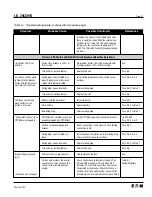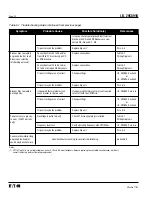
I.B. 29C891B
Page 37
Effective 11/98
TESTING A CIRCUIT BREAKER UNDER TRIP CON-
DITIONS WHILE IN SERVICE AND CARRYING LOAD
CURRENT, WHETHER DONE BY LOCAL OR
REMOTE MEANS, IS NOT RECOMMENDED.
ANY TRIPPING OPERATION WILL CAUSE A DIS-
RUPTION IN SERVICE AND POSSIBLE PERSONAL
INJURY RESULTING FROM UNNECESSARY
SWITCHING OF CONNECTED EQUIPMENT.
TESTING OF A CIRCUIT BREAKER THAT RESULTS
IN TRIPPING OF THE CIRCUIT BREAKER SHOULD
BE DONE ONLY WITH THE CIRCUIT BREAKER IN A
“TEST” OR “DISCONNECTED” CELL POSITION, OR
WHILE REMOVED TO A TEST BENCH.
Digitrip OPTIM 550, 750 and 1050 Trip Units have a test
capability. “No-Trip” and “Trip” tests can be performed
using any of the following:
• OPTIMizer Hand Held Programmer
(Figure
1-6
and I.B. 29C892))
• Breaker Interface Module (Model 550 with IMPACC kit)
(Figure
1-7
and I.B. 29C893)
• Remote computer/IMPACC software
(Figure
1-8
and I.B. 29C890)
Refer to the applicable instruction book for information
on performing tests using one of the outlined methods.
3-5.1 SECONDARY INJECTION TESTING
A test current may be injected into the secondary trans-
former terminals (5A level) for DSII/DSLII circuit break-
ers only. For K, L, N and R-Frame and SPB Pow-R cir-
cuit breakers, these terminals are either not present or
not accessible.
DSII and DSLII Type Power Circuit Breakers have a
field test kit receptacle that can be used for secondary
injection testing to test OPTIM Trip Units. With the
Auxiliary Power Module installed, the circuit breaker can
be tested using secondary currents provided by an
Amptector Trip Unit Test Kit. Refer to supplemental
DSII/DSLII Circuit Breaker information in Table
A.1
of
Appendix A for secondary injection testing details.
3-5.2 WHEN TO TEST
Tests can be performed with the circuit breaker in the
“Connected” position while carrying load current.
However, as stated in the CAUTION at the beginning of
this section, good practice will limit circuit breaker in-ser-
vice “Trip” tests to maintenance periods during times of
minimum load conditions. Testing is recommended with
the circuit breaker out of its cell or in an appropriate
“Test,” “Disconnected” or “Removed” cell positions.
Notice:
Since time-current settings are based on
desired system coordination and protection
schemes, the protection settings selected and
programmed should not be altered during or
as a part of any routine test sequence.
3-5.3 CONDUCTING TESTS
CIRCUIT BREAKER OPERATING MECHANISMS
OPEN AND CLOSE THE MOVING PARTS QUICKLY
AND WITH VERY HIGH ENERGY. TOUCHING THE
MOVING PARTS DURING OPERATION COULD
RESULT IN SERIOUS BODILY INJURY. KEEP
CLOTHING AND ALL PARTS OF THE BODY WELL
AWAY FROM ALL MOVING PARTS. IN ADDITION,
FOLLOW ALL INSTRUCTIONS GIVEN FOR TESTING
A SPECIFIC TYPE CIRCUIT BREAKER IN THE
APPROPRIATE INSTRUCTIONAL MATERIAL FOR
THAT CIRCUIT BREAKER.
Notice:
Testing will not be permitted to proceed if there
is greater than the following per unit of current
flowing on a phase or ground circuit:
• No-Trip Test
- >1.0 phase or 0.2 ground
• Trip Test
- >0.5 phase or 0.2 ground
The maximum permitted current value can be
determined by multiplying the appropriate per
unit value times the ampere rating of the
installed rating plug.
The Digitrip OPTIM test capability can be used to per-
form No-Trip and Trip tests. All testing requires control
power, except for No-Trip testing with the OPTIMizer
Hand Held Programmer. This testing can be accom-
plished using the internal battery power of the OPTIM-
izer. Control power, depending on the testing method,
can be supplied by an Auxiliary Power Module or by aux-
iliary power supplied to the circuit breaker (Figure
3-19
and paragraph 2-7). The auxiliary power is required to
activate the breaker’s flux transfer shunt trip.
CAUTION
WARNING
Summary of Contents for Digitrip OPTIM 1050
Page 7: ......











































